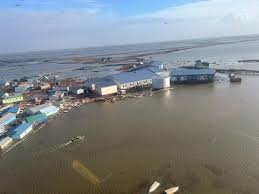
Introduction
Flooding in Alaska is becoming an increasingly pressing issue as the state’s unique climate and geography make it susceptible to severe weather events. In recent weeks, heavy rains and rapid snowmelt have caused several areas to experience significant flooding, disrupting communities, damaging infrastructure, and raising concerns about climate change. Understanding the recent events surrounding Alaska flooding is essential for residents, local officials, and anyone interested in the long-term implications for this northern region.
The Current Situation
As of mid-October 2023, communities such as Bethel and the surrounding Yukon-Kuskokwim Delta region are grappling with the aftermath of record-breaking rainfall. Reports from the National Weather Service indicated that some areas received more than five inches of rain in a short period, leading to river levels rising above flood stage. Local officials reported that many homes were inundated, roads were washed out, and schools had to close due to the dangerous conditions.
Residents described the experience as chaotic. “I’ve never seen anything like this in my life,” said local resident Maria Johnson. “Our backyard turned into a river, and we couldn’t leave our house for days.” Emergency services have been stretched thin as they work to rescue stranded individuals and deliver essential supplies to affected areas.
Government Response and Aid
The state government has mobilized resources to help those impacted by the flooding. Governor Mike Dunleavy announced an immediate response plan that includes deploying the Alaska National Guard to assist in evacuation efforts and providing essential supplies such as food, water, and medical assistance. The state has also reached out to federal agencies for additional support, with requests submitted for disaster relief funding.
Community organizations, including the Red Cross, have also stepped in, setting up shelters for displaced residents and offering resources for recovery. As reported, in just three days, volunteers have successfully assembled care packages for those in need, showcasing the resilience and solidarity of Alaskans during this crisis.
Looking Forward
Experts are warning that such flooding events might become more common as climate change continues to alter precipitation patterns and increase the risks of extreme weather. The Federal Emergency Management Agency (FEMA) and local policymakers are urged to invest in infrastructure improvements and emergency preparedness plans to mitigate the impact of future flooding.
The importance of sustainable practices and climate awareness cannot be overstated in the face of these rising threats. As Alaska faces an uncertain future due to climate fluctuations, the community’s ability to adapt, prepare, and respond will be crucial in safeguarding lives and property.
Conclusion
Alaska’s current flooding situation serves as a stark reminder of the vulnerabilities that come with living in an ever-changing environment. With the support of government agencies, local organizations, and the community, the efforts to recover can pave the way for a more prepared and resilient Alaska in the future. As we reflect on these events, it is clear that awareness, proactive measures, and collective action will be essential in facing the ongoing challenges of climate-related disasters.



